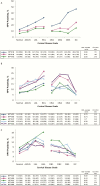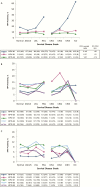Carcinogenicity of Human Papillomavirus (HPV) Types in HIV-Positive Women: A Meta-Analysis From HPV Infection to Cervical Cancer
- PMID: 28199532
- PMCID: PMC5399941
- DOI: 10.1093/cid/cix135
Carcinogenicity of Human Papillomavirus (HPV) Types in HIV-Positive Women: A Meta-Analysis From HPV Infection to Cervical Cancer
Abstract
Background: Data on the relative carcinogenic potential of human papillomavirus (HPV) types among women infected with human immunodeficiency virus (HIV) (WHIV) are needed to inform prevention programs for this population.
Methods: A systematic literature review and meta-analysis of high-risk HPV-type distribution in 19883 HIV-positive women was performed. The women, from 86 studies worldwide, included 11739 with normal cytological findings; 1784 with atypical squamous cells of undetermined significance (ASCUS); 2173 with low-grade and 1282 with high-grade squamous intraepithelial lesions (HSILs) diagnosed cytologically; 1198 with cervical intraepithelial neoplasia grade 1 (CIN1), 456 with CIN2, and 455 with CIN3 diagnosed histologically; and 796 with invasive cervical cancers (ICCs). A large proportion of WHIV, and almost all with ICCs, were from Africa.
Results: In Africa, HPV 16 accounted for 13% of HPV-positive WHIV with normal cytological findings, but this proportion increased through ASCUS, low-grade squamous intraepithelial lesions, CIN1, and CIN2 (18%-25%), up to 41%-47% for CIN3 and ICCs. Only HPV 16, HPV 18, and HPV 45 accounted for a greater proportion of HPV infections in ICCs compared with normal cytological findings (ICC:normal ratios, 3.68, 2.47, and 2.55, respectively). Other high-risk types accounted for important proportions of low- and/or high-grade lesions, but their contribution dropped in ICCs, with ICC:normal ratios in Africa ranging from 0.79 for HPV 33 down to 0.38 for HPV 56. Findings for HPV 16 and HPV 18 in Europe/North America, Asia, and Latin America were compatible with those from Africa.
Conclusions: HPV 16 and HPV 18 in particular, but also HPV 45, at least in Africa, warrant special attention in WHIV. Broad consistency of findings with those in HIV-uninfected population would suggest that the risk stratification offered by partial HPV genotyping tests also have relevance for HIV-positive women.
Keywords: cervical cancer; epidemiology; human immunodeficiency virus; human papillomavirus.
© The Author 2017. Published by Oxford University Press for the Infectious Diseases Society of America.
Figures



References
-
- International Agency for Research on Cancer. Biological agents. IARC Monogr Eval Carcinog Risks Hum 2012; 100B:1–475.
-
- Guan P, Howell-Jones R, Li N, et al. Human papillomavirus types in 115,789 HPV-positive women: a meta-analysis from cervical infection to cancer. Int J Cancer 2012; 131:2349–59. - PubMed
Publication types
MeSH terms
Grants and funding
LinkOut - more resources
Full Text Sources
Other Literature Sources
Medical

